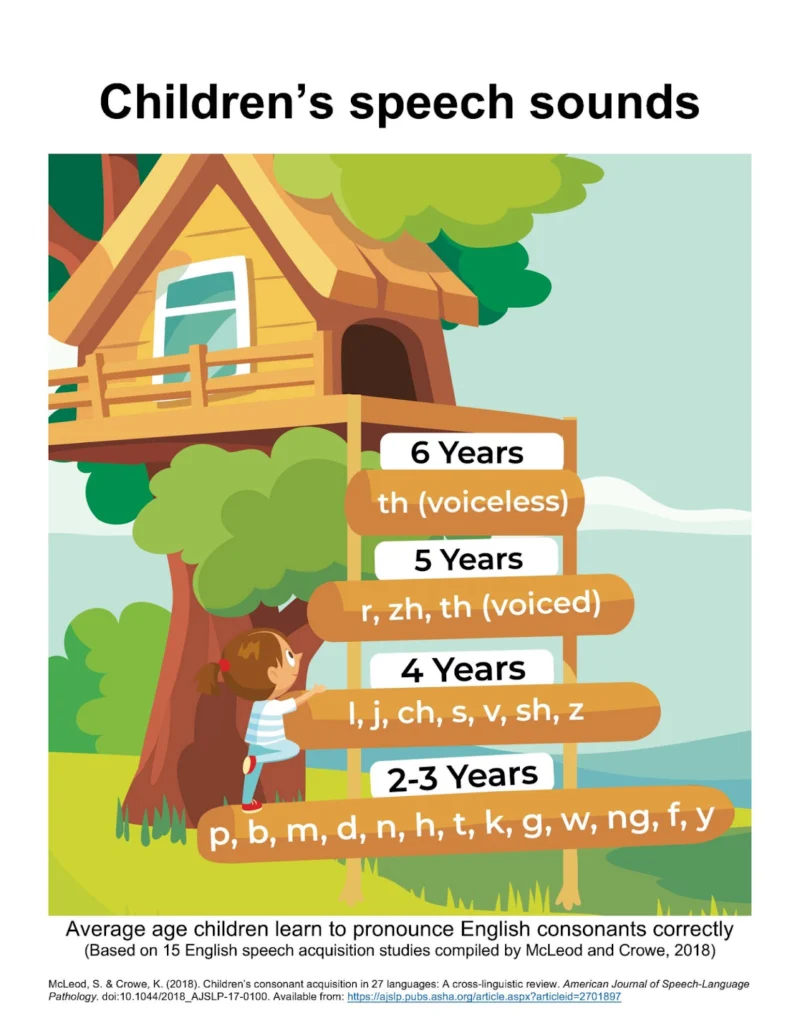
As parents and caregivers, we often wonder about the milestones of our children’s speech development. The question “Which sounds should my child be saying?” is complex, involving various factors such as articulation norms, phonological patterns, speech intelligibility, and contextual considerations. Let’s dive deep into the intricacies of speech sound development to give you a comprehensive understanding of what to expect as your child’s communication skills evolve.
Understanding Speech Sound Disorders
Before we explore typical development, it’s important to understand speech sound disorders (SSDs). SSDs are an umbrella term for difficulties with speech sound production. These can be broadly categorized into two types:
- Articulation disorders: Difficulty with the physical production of specific speech sounds.
- Phonological disorders: Difficulty organizing speech sounds in the brain, often resulting in patterns of sound errors.
Typical Speech Sound Development
Articulation Norms
Speech-language pathologists often refer to articulation norms to gauge a child’s progress. Two widely used sets of norms are:
- Iowa-Nebraska Norms (Smit et al., 1990)
- McLeod & Crowe Norms (2018)
These norms indicate the age at which 90% of children typically acquire specific sounds.
Here’s a simplified overview:

Phonological Pattern Norms
Children naturally use simplification patterns as they learn to speak. These patterns typically disappear as follows:
- Final Consonant Deletion (e.g., “ca” for “cat”): By age 3
- Cluster Reduction (e.g., “top” for “stop”): By age 4
- Fronting (e.g., “tat” for “cat”): By age 3-4
- Stopping (e.g., “do” for “zoo”): By age 3 for front sounds, age 5 for back sounds
- Gliding (e.g., “wabbit” for “rabbit”): By age 5
Speech Intelligibility Norms
Speech intelligibility refers to how well others can understand a child’s speech. Here are general guidelines:
- By age 2: 50% intelligible to unfamiliar listeners
- By age 3: 75% intelligible to unfamiliar listeners
- By age 4: 90% intelligible to unfamiliar listeners
- By age 5: Fully intelligible in connected speech
Contextual Factors in Speech Development
When assessing a child’s speech, it’s crucial to consider various contextual factors:
- Stimulability: Can the child produce the sound when given a model?
- Consistency: Does the child make the same error consistently or does it vary?
- Impact on communication: How much does speech error affect the child’s ability to communicate effectively?
- Phonological awareness: How well can the child manipulate sounds in words?
- Family history: Is there a family history of speech or language disorders?
Dialectal Considerations
It’s important to note that what may be considered an “error” in one dialect might be a standard feature in another. For example, in African American English, the “th” sound is often replaced with /d/ or /f/ depending on its position in the word. This is not a disorder, but a valid dialectal difference.
When to Seek Professional Help
While there’s a wide range of normal in speech development, consider consulting a speech-language pathologist if:
- Your child’s speech is significantly less intelligible than expected for their age
- Your child shows frustration when trying to communicate
- Your child is missing many sounds expected for their age group
- Simplified speech patterns persist well beyond the typical age of elimination
- Your child’s speech errors are impacting their social interactions or academic performance
Supporting Speech Sound Development at Home
Here are some strategies to foster your child’s speech development:
- Provide a language-rich environment with lots of talking, reading, and singing.
- Model clear speech without pressuring your child to repeat.
- Play sound games, focusing on the sounds your child finds challenging.
- Regularly read aloud age-appropriate books.
- Celebrate communication attempts, focusing on the message rather than perfect pronunciation.
- Repeat back the correct pronunciation without pointing out the error! Model model model!
Remember, every child’s path to clear speech is unique. While these guidelines provide a general roadmap, your child may progress at their own pace. Celebrate each milestone and don’t hesitate to seek professional guidance if you have concerns.

